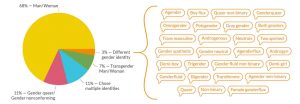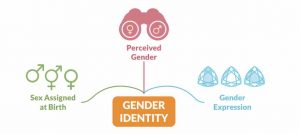Which Word Can Describe A Person's Gender Identity?
by Rory Gory
March 31 is Transgender Day of Visibility, an almanac occasion dedicated to celebrating the accomplishments of transgender people besides every bit raising awareness of and advocating for the transgender customs. Created in 2009 by Rachel Crandall, Executive Director of Transgender Michigan, Transgender Day of Visibility is a time for recognizing transgender people in a positive light, rather than only centering the conversation around the significant hardships facing the community.
While not all transgender or nonbinary people can or want to be visible in guild, having linguistic communication to depict gender identity and expression is extremely important. It helps avoid their erasure in legislation. Linguistic communication that affirms gender identity—including names, pronouns, and labels—can fifty-fifty exist lifesaving for immature people. Specific words that communicate the complexities of gender identity, such as agender, demigirl, bigender, andneutrois, tin assistance us advocate for and protect the rights of transgender and nonbinary people.
Based on findings from The Trevor Project'south National Survey on LGBTQ Youth Mental Health, these words and more were used by one in 4 LGBTQ youth who identified exterior of the gender binary in a report.

Trevor Project
These words as well show how young transgender and nonbinary people are leading the style in creating language that helps to limited the nuances of their gender identity and expression. Words that expand our agreement of gender across a binary give usa the tools to talk near our true experience of our gender identity.
While these changes in language tin be intimidating, you don't have to know every label to back up gender diverse people. By educating yourself on the basics of gender identity and expression, you can unlearn common myths about gender and promote inclusivity for transgender and nonbinary people.
What is gender identity?
Gender identity describes our internal understanding and experience of our ain gender. It can be influenced by culture, social club, and hormonal changes, merely ultimately, each person'due south feel of their gender identity is unique and personal.
Many people confuse sex activity and gender, or make the supposition that both sex activity and gender are inherently binary, or limited to the categories of male person and female (east.g., the inaccurate assertion that "There are only two genders!"). However, both sex and gender naturally autumn on a spectrum.
Because nosotros are used to binary thinking, people also commonly confuse gender with sexual orientation. Some people might presume, for instance, that being transgender is the aforementioned affair equally being gay. Other people might assume that your gender determines your sexual orientations (e.g., if you're a man, you'll exist attracted to women, and if you lot're a adult female, you'll be attracted to men). Sexual orientation is distinct from gender identity, and as well falls along a spectrum.

What is sex activity assigned at birth?
Sex is the nomenclature of a person every bit male, female, or intersex (inter–, "between, among"). Doctors typically designate female or male on a nascency certificate based on external genitals. Withal, human biology is not strictly limited to ii singled-out sexes.
Intersex people are born with whatever of several variations in sex characteristics including chromosomes, gonads, sex hormones, or genitals that do not fit the typical definitions for male or female bodies.
Gender is complex
It is unremarkably assumed that your gender volition friction match the sex activity you were assigned at nascency. According to this assumption, if you were assigned female person at birth (abbreviated as AFAB), you're a girl, and if you were assignedmale at nascency (AMAB), you're a boy. If a person'due south sexual practice assigned at nascency aligns with their gender this way, they are cisgender. However, transgender and nonbinary people take a gender identity that is different than the sex activity to which they were assigned at nascency.
Of the LGBTQ youth surveyed in The Trevor Project's report, only vii% selected transgender male or transgender female as their only gender identity. However, 32% of the sample identified as either transgender or used labels outside of the man/woman binary.
No matter what sex a person was assigned at birth or what label they use to describe themselves, their gender is theirs and theirs only to detect and ascertain.
What is gender expression?
Gender expression describes the way in which we present or limited our gender, such every bit our physical advent, wearable, hairstyles, and behavior. Gender expression can besides include behavior, move, and mannerisms, likewise as pronouns or honorifics (such as Mx.) to describe oneself.
Many people are used to using the pronouns he and she (and their related forms, his/him and hers/her) to address male and female identified people, respectively. In recent years, however, the singular they pronoun has become a pop and widespread gender-neutral alternative to the traditionally gendered pronouns, he and she.
There are many other pronouns than nonbinary atypical they that people outside the gender binary use. Here are some examples (listed in nominative, possessive, objective, and reflexive forms):
- she, her/hers, herself
- he, his, him, himself
- they, them, their, theirs, themself
- ze (or zie), hir/hirs, hir, hirself
- ze (or zie), zir/zirs, zir, zirself
- xe, xyr/xyrs, xem, and xemself
- ve, vis, ver, and verself
For more tips on how to use pronouns respectfully, you can reference The Trevor Project's Guide to Being an Marry to Transgender and Nonbinary Youth.
Gender expression can be a joyful vehicle for self-expression, and it isn't limited to transgender and nonbinary people. Cisgender men and women also brand choices equally to whether they want to express their gender in ways that are feminine, masculine, or androgynous. No affair what your gender identity, yous accept a right to express your gender however you lot want!
The pitfalls of perceived gender
People perceive gender based on a variety of visual and social cues, for example, a person's gender expression, their secondary sex activity characteristics (such equally the development of breasts or a beard), or the social role they are playing relative to expected gender roles. Many people commonly brand assumptions about a person's gender identity or pronouns based on their perceived gender, simply you tin't tell a person's gender just by looking at them.
Many cisgender people take for granted that their gender volition exist correctly perceived, but many binary transgender people struggle with microaggressions based on their perceived gender. Snap judgments tin can result in misgendering, or using pronouns or forms of address that do not correspond with a person'southward gender. By using gender-neutral linguistic communication and introducing yourself with your pronouns, y'all can make sure that y'all're addressing others respectfully.
Passing is a controversial term used to draw whether or not a person is perceived as a certain gender (e.g., passing every bit a woman or passing as a man). On the ane hand, for many transgender people, existence able to "pass" as the gender they align with is important for a sense of cocky, and what'southward called passing privilege can allow 1 to movement safely through environments where existence perceived as transgender is a danger.
On the other hand, passing can be considered problematic because the discussion passing can imply that a person has to "convince" others of their gender, rather than existence able to merely express their truthful self. Implying that transgender people are lying, tricking, or deceiving other people by expressing their gender is inaccurate and stigmatizing.
The trans customs is diverse
Many transgender and nonbinary teens are lumped under a unmarried "transgender" category regardless of gender, which includes anyone who isn't cisgender: trans men, trans women, nonbinary people, and anyone with a label that identifies them outside the gender binary.
But, LGBTQ youth surveyed in The Trevor Project's report identified with more than 100 gender identities that otherwise popularly become grouped together nether the transgender umbrella. The transgender community is non a monolith, and the category of transgender represents an extremely diverse group.
Nonbinary is a specific identity label and a wide adjective used to describe people who experience their gender identity and/or gender expression equally outside of the traditional male person/female gender binary, but many other words may be used to describe identities outside the traditional categories of man and adult female, too. These identities, while similar, are non necessarily interchangeable or synonymous.
For example, neutrois and agender people identify without a gender, or experience their gender as gender-neutral. People who identify equally genderqueer, gender-fluid, or genderflux, on the other mitt, may experience a fluid or fluctuating gender between a variety of identities and expressions.
Other people who do non identify as strictly male or female may even so limited and identify their gender in masculine, feminine, or androgynous means. Bigender people (bi–, "two") ofttimes experience two gender identities, either simultaneously or varying between the two. Demigender (demi–, "half") describes nonbinary gender identities that have a partial connection to a certain gender, such every bit demigirl, or someone who partially identifies as a woman or with feminine characteristics.
Labels are personal …
Labels can be an heady way to express your truthful self to others, and to communicate with those who chronicle to your experiences. Using more specific labels can aid to filter through millions of search results on the internet to find, connect with, and build community with other people who share your identity.
Information technology's OK if you don't understand all the words that exist to describe gender identity, but avoid invalidating others for using labels that are unfamiliar to you. At the same time, be conscientious not to tell others how you think they should or shouldn't label their gender. Information technology's OK not to label yourself, too. In that location is no right or wrong way to define your gender.
… and using respectful language can save lives
Discovering so many new words to draw one's gender identity can feel overwhelming for those who have spent most of their lives operating on the assumption that male person and female are the merely genders. At times, there can be resistance to discovering the descriptions of gender identity and expression that young people are discussing.
If y'all're wondering whether all this new linguistic communication is necessary, keep in listen that affirming a young person's gender identity tin literally be lifesaving. In a contempo study, the usage of the chosen names of transgender and nonbinary youth resulted in a 29% decrease in suicidal ideation and a 56% decrease in suicidal beliefs for each boosted context in which information technology was used. By encouraging young people to limited themselves, and modeling the language they use to describe themselves, you can support positive mental health outcomes for transgender and nonbinary youth.
You don't have to exist an skilful or memorize all the words in this article to exist supportive. But listening and practicing empathy goes a long way to helping others. Language is always changing, and no matter what your historic period, we're all continually learning new words to draw and communicate our experience of gender.
Rory Gory is the Digital Marketing Director for The Trevor Projection, the world'south largest suicide prevention and crisis intervention organization for lesbian, gay, bisexual, transgender, queer & questioning (LGBTQ) young people. If you or anyone you lot know is in crunch, attain out to The Trevor Projection for back up at: thetrevorproject.org/help.
If you're concerned about creating safe and supportive environments for youth of all genders, you can refer to The Trevor Project's Guide to Being an Ally to Transgender and Nonbinary Youth.
Read more from Rory Gory on Dictionary.com in their articles: "What Does It Hateful To Be 'Asexual'?" | "How The Letter 'X' Creates More Gender-Neutral Linguistic communication" | "Why Is 'Bisexual' Such A Charged Word?"
Source: https://www.dictionary.com/e/transgender-nonbinary-gender-identity-terms/
Posted by: griffithcress1987.blogspot.com

0 Response to "Which Word Can Describe A Person's Gender Identity?"
Post a Comment